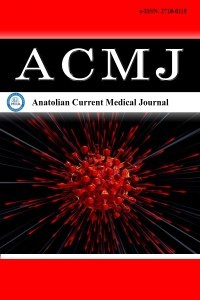1.
Kusior ME, Pejka K, Knapik M, Sajuk N, Klaptocz S, Konopka T.Analysis of the nature of injuries in victims of fall from height.Analiza charakteru obrazen u ofiar upadków z wysokosci. ArchMed Sadowej Kryminol. 2016;66(2):106-124.
2.
Taviloğlu K, Aydın A, Çuhalı BD, Demiralp T, Güloğlu R, ErtekinC. Olgularımızın birinci derece travma merkezine sevk edilmekriterlerine uygunluğunun değerlendirilmesi. Ulusal TravmaDerg. 2001;7(3):146-150.
3.
World Health Organization. 2012. Retrieved 3 December 2012.
4.
World Health Organization. Preventing suicide: a globalimperative. Switzerland: Geneva; 2014.
5.
Çuhadaroğlu F, Akdemir D. Ergenlerde intihar davranışı. KatkıPediatri Derg. 2013;1:97-105.
6.
Shain B, Braverman PK, Adelman WP. Committee onadolescence. suicide and suicide attempts in adolescents. Pediatr.2016;138(1):e20161420.
7.
Alizo G, Sciarretta JD, Gibson S, et al. Fall from heights: doesheight really matter? Eur J Trauma Emerg Surg. 2018;44(3):411-416.
8.
Lee S, Koo B, Yang S, Kim J, Nam Y, Kim Y. Fall-from-heightdetection using deep learning based on IMU sensor data foraccident prevention at construction sites. Sensors. 2022;22(16):6107.
9.
Robson LS, Lee H, Amick III BC, Landsman V, Smith PM,Mustard CA. Preventing fall-from-height injuries in construction:effectiveness of a regulatory training standard. J Safety Res.2020;74:271-278. doi.org/10.1016/j.jsr.2020.06.007
10.
Lohanathan A, Hazra D, Jyothirmayi CA, Kundavaram AP. Anelucidation of pattern of injuries in patients with fall from height.Indian J Crit Care Med. 2020;24(8):683-687.
11.
Lim KT, Choi WJ. Effect of fall characteristics on the severityof hip impact during a fall on the ground from standing height.Osteoporos Int. 2020;31(9):1713-1719.
12.
Salimi JZM. An epidemiologic study of trauma patients admittedto the Hospital Ahwaz Golestan. Payesh Quarterly. 2008;7(2):115-120.
13.
Zamani M, Esmailian M, Mirazimi MS, Ebrahimian M, GolshaniK. Cause and final outcome of trauma in patients referred to theemergency department: a cross sectional study. Iranian J EmergMed. 2014;1(1):22-27.
14.
Papadakis SA, Pallis D, Galanakos S, et al. Falls from height dueto accident and suicide attempt in Greece. a comparison of theinjury patterns. Injury. 2020;51(2):230-234.
15.
Choi JH, Kim SH, Kim SP, et al. Characteristics of intentional fallinjuries in the ED. Am J Emerg Med. 2014;32(6):529-534.
16.
Dickinson A, Roberts M, Kumar A, Weaver A, Lockey DJ.Falls from height: injury and mortality. J R Army Med Corps.2012;158(2):123-127.
17.
Kort I, Hmandi O, Grayaa M, et al. A comparative study of theinjury pattern between suicidal and accidental falls from heightin Northern Tunisia. J Forensic Leg Med. 2023;97:102531.
18.
Madigan S, Korczak DJ, Vaillancourt T, et al. Comparisonof paediatric emergency department visits for attemptedsuicide, self-harm, and suicidal ideation before and during theCOVID-19 pandemic: a systematic review and meta-analysis.Lancet Psychiatry. 2023;10(5):342-351.
19.
Peng JL, Liu X, Peng C, Shao Y. Comprehensive factor analysisand risk quantification study of fall from height accidents.Heliyon. 2023;9(12):e22167. doi:10.1016/j.heliyon.2023.e22167
20.
Türkoğlu A, Sehlikoğlu K, Tokdemir M. A study of fatal fallsfrom height. J Forensic Leg Med. 2019;61:17-21. doi:10.1016/j.jflm.2018.10.008

